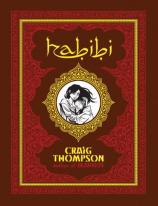Habibi
Review
Habibi
Habibi is a true example of what a graphic novel can and should be. Not merely a story with pictures, or a picture book with a long story attached, Habibi is a real marriage of words and pictures, where each component is elevated to the level of a true art form and each propels the other to further heights.
No simple review can do the book true justice; it’s simply too long and too ornate to be properly summarized quickly. But that’s a true strength of the book: You will be immersed in its pages and captivated by its beauty throughout.
At the beginning of Habibi, Dodola is a young girl sold into slavery by her parents. She’s brash and intelligent, and her feisty spirit can hardly be contained, especially once her new, much older husband teaches her how to read. She manages to escape him, and then finds another lost child, the even younger Zam, a black slave she rescues and then begins to raise. The two make their way alone in a strange, dangerous Middle Eastern land that is at once both ancient and new, modern yet timeless. They find an abandoned shipwreck in the middle of the desert and they make it their home for a while, and Dodola teaches Zam in the ways of the world. They are together there for a long time, and as time passes, Zam begins to mature and look at Dodola in different ways…their relationship moves from playful to more serious, at least in his mind, which brings him great shame and propels one of the book’s many driving themes: the shame and doubt that can be created by wanton sex.
This is territory that Thompson somewhat mined in the autobiographical Blankets, but here the story is more expansive, more worldly, and more inclusive. Dodola, in order for them both to survive, must sell her body to passing desert travelers in order to provide food for herself and Zam. She has made her peace with this sacrifice she must make and sees it more as a way the world works than anything else, but when Zam inadvertently discovers what she’s been doing, their relationship changes even more significantly.
Zam, in one of the book’s other major themes, is the water-bringer. He has an uncanny ability to find and provide it. The duality in the pair’s relationship is explored throughout the massive book, as is the duality in so much of the world. Most obvious is the intertwining of Christianity and Islam; Thompson presents a multitude of familiar biblical stories through the lens of the Quran and shows just how similar both of them are. In the wake of anti-Islamic sentiments in the United States and much of the world, it’s a noble effort to show unity in a world that seeks to divide.
Over and over, Habibi mesmerizes and shocks and then soothes. As the story moves through time and space, Dodola and Zam become more ensnared in the ancient ways of their culture and humanity while the book marches into distinctly modern problems (pollution, construction, globalism). Throughout it all, as the characters age and the story progresses, the reliable constant is Thompson’s amazing artwork. Each page is a wonder to behold, whether it’s an ornate and vividly detailed tapestry, a cleverly executed escape sequence, a vivid religious parable brought to stunning life, a desert trek, or something else culled from Thompson’s vivid imagination. This is indeed a true marriage of word and picture, the kind that only benefits from repeated readings where the reader can continuously discover, again and again, something new.
In the span of Habibi’s nearly 700 pages, Craig Thompson covers ground ranging from creation myths, sexuality, and industrialism to the broader themes of love and religion. It’s a triumph from beginning to end.
Reviewed by John Hogan on September 9, 2011
Habibi
- Publication Date: September 20, 2011
- Genres: Fiction, Graphic Novel
- Hardcover: 672 pages
- Publisher: Pantheon
- ISBN-10: 0375424148
- ISBN-13: 9780375424144




